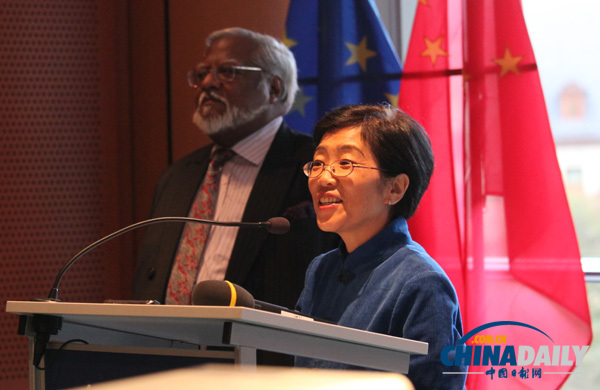Promising start for new partnership era with the EU
By Fu Jing (China Daily) Updated: 2015-12-23 08:07
 |
|
Yang Yanyi, Head of the Chinese Mission to the EU is seen in this file photo taken in October of 2014. [Photo by Fu Jing/chinadaily.com.cn] |
After spending two years getting to understand each other's respective positions, the leaderships of China and the European Union are determined to seek synergies in each other's mega-projects, Beijing and London have pledged to form a global strategic partnership and, Beijing and Paris worked together to reach a historic deal on climate change.
Amid the global economic downturn, these developments have deepened China's ties with the EU, building the momentum for both to work on the most difficult part of their collaboration, that is, implementation.
In addition to a variety of diplomatic moves, China is likely to make more efforts and inject more resources in the economy to ensure 2016 turns out to be a better year, especially because next year marks the beginning of its 13th Five-Year Plan (2016-20) period. With many strategic blueprints in hand, China should make every effort to make 2016 the beginning of a new and more fruitful era of its partnership with the EU by implementing its plans at different levels.
Beijing and Brussels should get down to business in earnest next year, for which they have to raise their strategic partnership when the Chinese and Europeans return to work after Christmas and New Year. In this regard, China and the United Kingdom set an excellent example for other European powers and the EU in 2015.
The UK was the first EU country to recognize China's global influence and its role in offering global solutions to make the world a better and fairer place. A part of the UK's efforts was its support for China's initiatives of reforming the global financial regime and offering public goods for global growth.
The Chinese and EU leaderships have to boost China-France, China-Germany and overall China-EU relations to the level of that between China and the UK, which support each other's strategic decisions on the global stage.
After the founding of New China in 1949, France was one of the first European countries to establish ties with China.
China and the EU have just celebrated the 40th anniversary of their diplomatic relations, and they should view the new era with renewed ambition. Only with strategic determination can the two sides speak the same economic language and give practical shape to their big ideas.
China and the EU have already decided to synergize the Beijing-led Belt and Road Initiative and the 315 billion ($342.31 billion) European Investment Scheme. China is the first country outside the EU to come up with such a proposal, which demands huge financial inputs. China is thus playing a very constructive role in consolidating Beijing-Brussels ties. Now China and the EU should make good use of this momentum to pool their resources together for the benefit of peoples on both sides.
In addition, since the Paris climate agreement has mapped out a direction of realizing low-carbon economic development, Beijing and Brussels should act quickly to implement the mega-proposals they have agreed on, with the focus on infrastructure projects, digital economy, high-tech manufacturing, environmental protection, renewable energy and agricultural cooperation.
To achieve this, both sides have agreed to set up a joint fund. But they should also finalize a timetable and the structure to give life to such operations. Both sides should also welcome each other in their respective markets. In particular, the EU has to think long term. For example, it could seek China's help to build a pan-European high-speed railway network.
So, creating opportunities for the other side should be high on the agenda of Chinese and EU officials in 2016. They should also create a sound atmosphere for peoples on both sides to trade with and invest in each other's economies.
The author is China Daily chief correspondent in Brussels. fujing@chinadaily.com.cn

I’ve lived in China for quite a considerable time including my graduate school years, travelled and worked in a few cities and still choose my destination taking into consideration the density of smog or PM2.5 particulate matter in the region.











